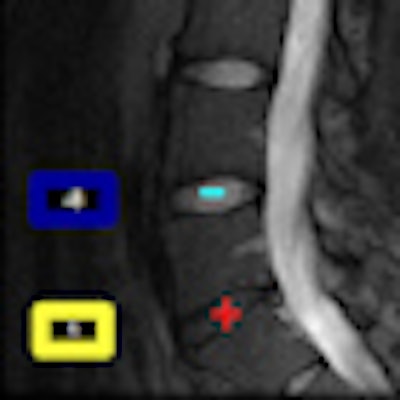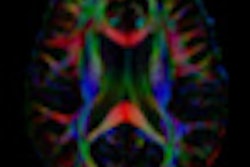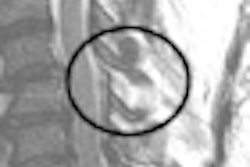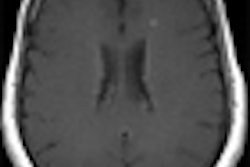
A California company with roots at the University of California, San Francisco (UCSF) is having early success in developing technology to noninvasively diagnose and localize back pain with the help of MR spectroscopy.
Redwood City-based Nocimed currently is testing Nociscan, a software package designed to enhance standard MR images with an additional MR spectroscopy sequence and postprocessing to detect the chemical signatures of painful disks, a process the company calls degenerative disk disease MR (DDD-MR) spectroscopy.
Nociscan's roots came from UCSF, where researchers began to develop the technology in 2003 through a grant from the National Institutes of Health (NIH).
"We exclusively licensed the technology, taking it fairly directly to clinic at the beginning of 2008 at UCSF under a biodiscovery grant program at the University of California," said James Peacock, founder and CEO of Nocimed. The initiative is designed, in part, to develop and match technology from the state's colleges with commercial sponsors.
"This technology was spawned by a basic scientific understanding of disk pain and the changing chemistry of disks as they degenerate and become painful," Peacock added. "Basic science research done at UCSF determined what biomarkers appear to correlate most strongly for discogenic pain. This initial breakthrough understanding has been both confirmed and expanded upon via our clinical experience and evaluation since."
Chemical biomarkers
The primary chemical biomarkers are lactate, which relates to disk acidity, and proteoglycan, which relates to potential nerve in-growth into disks. The Nociscan MR spectroscopy platform acquires and processes MR spectroscopy data at spectral regions associated with these chemicals, among others.
"Lactic acid builds up in painful disks, which is the same thing that makes muscles hurt," Peacock said. "A normal, healthy disk is high in proteoglycan and high in water. Proteoglycan is what holds water in the disks. As the disk degenerates, it becomes darker and the water dehydrates and proteoglycan breaks down. This chemical also prevents nerve in-growth."
"Its decrease is believed to create a permissive environment for innervation of nociceptors [pain reporting nerves] that has been observed in the inner nuclei of degenerative painful disks, but which is not found in that area in healthy disks high in proteoglycan content," Peacock added. "Generally speaking, nociceptive nerves plus increased acidity often means pain."
Currently, patients with lower back pain must undergo an invasive procedure known as provocative discography to help determine the source of the pain. A needle is inserted into a patient's spine and a dye then is injected into the disk until the patient reaches his or her pain threshold. Based on the level of pain expressed by the patient, the physician forms the diagnosis.
As for a noninvasive MRI scan alone, the modality is limited in what it can detect for the source of discogenic low back pain. "MRI is great for showing structural abnormalities, but with contained axial discogenic back pain, a most prevalent condition, MRI cannot differentiate which disk is causing the pain," Peacock said. "All that MRI shows are structural abnormalities, mostly the degree of disk degeneration. More than half of people who are over 40 years old and have degenerative disk disease in their lumbar spine are pain-free. That's the problem -- not all degenerative disks are painful and not all painful disks are degenerative."
Two-year study
To develop the platform for clinical use and gauge Nociscan's accuracy, the company embarked upon a two-year study, initially developing and using the new application platform for compatibility with a 3-tesla MRI systems (Signa, GE Healthcare, Chalfont St. Giles, U.K.) and spine detector coil. The ultimate objective was to test the potential efficacy of its painful DDD-MR spectroscopy diagnostic against control measures for pain, including disks with either positive or negative discography results in pain patients, and disks presumed nonpainful in asymptomatic control volunteers.
The control comparison study analyzed 79 disks from 42 subjects, of which the first 72 disks were used to statistically train a diagnostic algorithm for optimal correlation to controls and seven disks were included under prospective use of that algorithm. Thirty disks came from 14 patients with a clinical diagnosis of chronic, severe low back pain and at least one positive discogrammed disk, while 49 disks were from 28 asymptomatic volunteers. Procedural success, based on confidence intervals from the data for determining a confident diagnosis, was determined in 74 of 79 (94%) of these disks.
The study analysis determined that the DDD-MR spectroscopy procedural successes correctly matched 73 of 74 (99%) disks from all positive and negative diagnoses among patients in the provocative discography and asymptomatic groups.
 |
| Nocigram versus discogram -- two pain patient examples. The images show a degenerative disk at L5-S1 for both patients, which were found to be painful by both discogram and Nocigram. However, at L4-L5 where the disk appears normal anatomically, the disk was painful according to the discogram and the Nocigram. Images courtesy of Nocimed. |
Of the 12 MR spectroscopy-positive disks, all 12 were from the positive control group, representing a positive predictive value of 100%. Of the 62 disks that were MR spectroscopy-negative, 61 disks were from the negative control group, representing a negative predictive value of 98%.
DDD-MR spectroscopy also matched results in 25 of 26 (96%) disks in the provocative discography group alone, including all of 13 (100%) disks receiving a negative discogram.
The exam also matched all 48 (100%) negative control results in the asymptomatic group where a discogram has often been challenged for potential to produce false positive rates. Peacock said the company is especially encouraged that no false positives, as determined by these diagnostic control standards, were observed in any of the 61 negative control disks evaluated.
"In today's standard of care, MRI followed by discogram is controversial," Peacock said. "By replacing the discogram by extending MRI with additional pulse sequence, Nociscan proposes to increase the utility of the MR noninvasively to tell which disk would have been a positive or negative discogram. Essentially, it is a virtual discogram, though with potential to be even more accurate, with lower potential for false positive results."
Nociscan currently remains investigational and is not yet approved for sale or commercial use in the U.S. or abroad. Nocimed's plan is to extend its research with further development and characterization and then a prospective trial at other medical centers, which the company hopes to launch before the end of this year, for more evidence of the technology's efficacy and in pursuit of regulatory approvals.
Nocimed also is focused on determining with which vendors' MRI platforms Nociscan will be further developed for compatibility in taking the new application to the market.
By Wayne Forrest
AuntMinnie.com staff writer
May 18, 2010
Related Reading
Stand-up MRI detects impact of heavy backpacks on children, January 6, 2010
MRI's growth may lead to more back surgeries, October 15, 2009
Study questions routine x-rays, MRIs for back pain, February 6, 2009
U.S. back pain costs rise but pain still there, February 14, 2008
Copyright © 2010 AuntMinnie.com



















